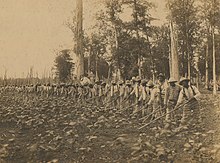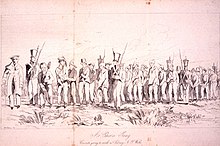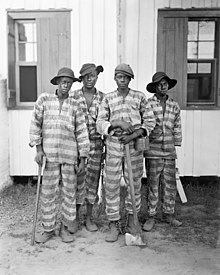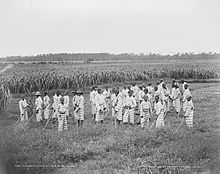Chain gang


A chain gang or road gang is a group of prisoners chained together to perform menial or physically challenging work as a form of punishment. Such punishment might include repairing buildings, building roads, or clearing land.[1] The system was notably used in the convict era of Australia and in the Southern United States. By 1955 it had largely been phased out in the U.S., with Georgia among the last states to abandon the practice.[2] Clallam County, Washington, U.S. still refers to its inmate litter crew as the "Chain Gang."[3] North Carolina continued to use chain gangs into the 1970s.[4][5] Chain gangs were reintroduced by a few states during the "get tough on crime" 1990s: In 1995, Alabama was the first state to revive them. The experiment ended after about one year in all states except Arizona,[6] where in Maricopa County inmates can still volunteer for a chain gang to earn credit toward a high school diploma or avoid disciplinary lockdowns for rule infractions.[7]
Synonyms and disambiguation
[edit]This section needs additional citations for verification. (May 2024) |
A single ankle shackle with a short length of chain attached to a heavy ball is known as a ball and chain. It limited prisoner movement and impeded escape.
Two ankle shackles attached to each other by a short length of chain are known as a hobble or as leg irons. These could be chained to a much longer chain with several other prisoners, creating a work crew known as a chain gang. The walk required to avoid tripping while in leg irons is known as the convict shuffle.

A group of prisoners working outside prison walls under close supervision, but without chains, is a work gang. Their distinctive attire (stripe wear or orange vests or jumpsuits) and shaven heads served the purpose of displaying their punishment to the public, as well as making them identifiable if they attempted to escape. However, the public was often brutal, swearing at convicts and even throwing things at them.[8]
The use of chains could be hazardous. Some of the chains used in the Georgia system in the first half of the 20th century weighed 20 pounds (9 kg). Some prisoners suffered from shackle sores—ulcers where the iron ground against their skin. Gangrene and other infections were serious risks. Falls could imperil several individuals at once.
Modern prisoners are sometimes put into handcuffs or wrist manacles (similar to handcuffs, but with a longer length of chain) and leg irons, with both sets of manacles (wrist and ankle) being chained to a belly chain. This form of restraint is most often used on prisoners expected to be violent, or prisoners appearing in a setting where they may be near the public (a courthouse) or have an opportunity to flee (being transferred from a prison to a court). Although prisoners in these restraints are sometimes chained to one another during transport or other movement, this is not a chain gang—although reporters may refer to it as such—because the restraints make any kind of manual work impossible.
Purpose
[edit]
Various claims as to the purpose of chain gangs have been offered. These include:
- punishment
- societal restitution for the cost of housing, feeding, and guarding the inmates. The money earned by work performed goes to offset prison expenses by providing a large workforce at no cost for government projects, and at minimal convict leasing cost for private businesses[citation needed]
- a way of perpetuating African-American servitude after the Thirteenth Amendment to the United States Constitution ended slavery outside of the context of punishment for a crime.[9]
- reducing inmates' idleness[citation needed]
- to serve as a deterrent to crime[10]
- to satisfy the needs of politicians to appear "tough on crime"[citation needed]
- to accomplish undesirable and difficult tasks[citation needed]
History
[edit]Australia
[edit]
In the Australian penal colonies, chain gangs were also referred to as "iron gangs". They were used as a punishment for convicts who reoffended after being transported. Iron gangs were frequently employed on the construction of roads in remote areas where escape was a possibility, such as on the Great North Road from Sydney to the Hunter Valley and the road from Sydney to Bathurst over the Blue Mountains. The leg irons were installed by blacksmiths using hot rivets, and then attached to a single "gang chain" to allow for control by an overseer.[12] The irons and chains could weigh as much as 4.5 kilograms (9.9 lb) or more.[13] Some of the convicts on iron gangs were as young as 11 years old.[14]
The use of iron gangs in the Colony of New South Wales was expanded by Governor Ralph Darling as part of his infrastructure program. Their tasks included "breaking rocks, clearing trees, [and] constructing stone culverts and bridges".[14] In 1828, the colony's chief surveyor Edmund Lockyer directed that each iron gang could contain up to 60 men, supervised by one main overseer and three assistants. The iron gangs "received the worst and least trustworthy characters, together with the strictest security measures". Better-behaved convicts still worked in gangs but were unshackled.[15] Convicts who escaped from iron gangs were described as "bolters" and became some of the first bushrangers.[14]
United States
[edit]
The introduction of chain gangs into the United States began after the American Civil War. The Southern states needed finances and public works to be performed. Prisoners were a free way for these works to be achieved.[16]
The use of chain gangs for prison labor was the preferred method of punishment in some Southern states like Florida, Georgia, Louisiana, Virginia, North Carolina, Arkansas, Texas, Mississippi, and Alabama.[17]
Abuses in chain gangs led to reform and to their general elimination by 1955.[9]: 456 There were still chain gangs in the South in December 1955.
Chain gangs experienced a resurgence when Alabama began to use them again in 1995; they still existed in 1997.[9]: 456–457 [needs update]
Reintroduction
[edit]Several jurisdictions in the United States have re-introduced prison labor. In 1995 Sheriff Joe Arpaio reintroduced chain gangs in Arizona.[18]
A year after reintroducing the chain gang in 1995, Alabama was forced to again abandon the practice pending a lawsuit from the Southern Poverty Law Center, among other organizations. The SPLC's attorney, J. Richard Cohen, said, "They realized that chaining them together was inefficient; that it was unsafe". Alabama Prison Commissioner Ron Jones was fired in 1996 for trying to put female prisoners on chain gangs.[19][20] However, as late as 2000, Jones had proposed reintroducing the chain gang.


In 2011, Tim Hudak, former leader of the Progressive Conservative Party of Ontario in Canada, campaigned on introducing penal labour in the province, referred to by many as chain gangs.[21] He lost seats to the provincial Liberals which formed another majority government in the subsequent general election.
According to their own policies, Britain First (a British far-right political organization) want to re-introduce chain gangs "to provide labour for national public works". This is part of their aim to turn prisons from "cosy holiday camps" into "a place of hard labour".[22]
In 2013, Brevard County Jail in Sharpes, Florida reintroduced chain gangs as a deterrent on crime in a pilot project. Ex-convict Larry Lawton, critical of this move, said, "Chain gangs send a bad message about our county", adding "I don't think people want to come to this county as a tourist or a beach person and see people in chains." Instead he proposed a better use of law enforcement resources would be to combat drug addiction because he says it is a "contributing factor" to criminal activity.[10]
See also
[edit]Footnotes
[edit]- ^ "Chain Gangs". Credo Reference. Archived from the original on 17 February 2021. Retrieved 3 October 2013.
- ^ Roth, Mitchel P (2006). Prisons and prison systems. Greenwood Publishing Group. pp. 56–57. ISBN 978-0-313-32856-5.
- ^ "Chain Gang | Clallam County, WA". www.clallamcountywa.gov. Retrieved 2024-08-16.
- ^ "North Carolina: Voices from the Chain Gang | States of Incarceration". Statesofincarceration.org. Archived from the original on 2019-02-21. Retrieved 2019-02-21.
- ^ Wooten, James T. (October 23, 1971). "Prison Road Gangs Fading Fast in South". The New York Times. Archived from the original on February 21, 2019. Retrieved February 21, 2019.
- ^ Banks, Cyndi (2005). Punishment in America: a reference handbook. ABC-CLIO. pp. 154–156. ISBN 978-1-85109-676-3.
- ^ "Anderson Cooper 360 transcript". CNN. March 10, 2004. Archived from the original on 2011-06-04. Retrieved 2009-06-07.
- ^ McShane, Marilyn D. (1996). Encyclopedia of American Prisons. Garland Publishing Inc. p. 71. ISBN 978-0-8153-1350-2.
- ^ a b c Gorman, Tessa M. (March 1997). "Back on the Chain Gang: Why the Eighth Amendment and the History of Slavery Proscribe the Resurgence of Chain Gangs". California Law Review. 85 (2): 441–478. doi:10.2307/3481074. JSTOR 3481074. Archived from the original on 2019-04-27. Retrieved 2019-08-15.
- ^ a b Ford, Andrew (May 2, 2013). "Florida sheriff reintroduces chain gang". USA TODAY. Gannett Satellite Information Network. Florida Today. Retrieved 2021-02-17.
- ^ "R4171 Convict chain gang at Hobart, 1833". NSW Department of Education. Archived from the original on 29 September 2020. Retrieved 1 November 2020.
- ^ "Iron gang chain". Sydney Living Museums. Archived from the original on 12 November 2020. Retrieved 1 November 2020.
- ^ "The convict experience". State Library of New South Wales. Archived from the original on 3 November 2020. Retrieved 1 November 2020.
- ^ a b c "A world of pain". Sydney Living Museums. Archived from the original on 8 November 2020. Retrieved 1 November 2020.
- ^ Karskens, Grace (1986). "Defiance, Deference and Diligence: Three Views of Convicts in New South Wales Road Gangs" (PDF). Australasian Historical Archaeology. 4: 19. Archived (PDF) from the original on 2020-04-04. Retrieved 2020-11-01.
- ^ Wallenstein, Peter. "Chain Gangs". Credo Reference. Archived from the original on 17 February 2021. Retrieved 2 October 2013.
- ^ McShane, Marilyn D. (1996). The Encyclopedia of American Prisons. Garland Publishing Inc. pp. 71–73. ISBN 978-0-8153-1350-2.
- ^ Fernández, Valeria (August 21, 2017). "Arizona's 'concentration camp': why was Tent City kept open for 24 years?". Guardian Media Group. Archived from the original on February 9, 2021. Retrieved February 10, 2021.
Inmates were forced to work on chain gangs – which, save for a few exceptions, had been abandoned by the US in 1955. Maricopa County ran the only all-female chain gang in the country.
- ^ Times staff and wire report (1996-04-27). "Nation IN BRIEF: ALABAMA: Official Fired Over Female Chain Gangs". Los Angeles Times. Retrieved 2023-12-05.
- ^ "Alabama Prison Chief Fired over Women in Chains | Prison Legal News". Prison Legal News. 1996-07-15. Retrieved 2023-12-05.
- ^ Benzie, Robert (July 18, 2011). "Hudak's chain-gang proposal is a danger to public, Liberals warn". Toronto Star. Archived from the original on August 6, 2011. Retrieved August 3, 2011.
- ^ "BRITAIN FIRST OFFICIAL POLICIES". Britain First - OFFICIAL WEBSITE. Archived from the original on 2020-10-10. Retrieved 2020-10-04.
Further reading
[edit]- Burns, Robert E. I Am a Fugitive from a Georgia Chain Gang! University of Georgia Press; Brown Thrasher Ed edition (October 1997; original copyright, late 1920s).
- Childs, Dennis. Slaves of the State: Black Incarceration from the Chain Gang to the Penitentiary. Minneapolis, MN: University of Minnesota Press, 2015.
- Colvin, Mark. Penitentiaries, Reformatories, and Chain Gangs: Social Theory and the History of Punishment in Nineteenth-Century America. Palgrave Macmillan (2000). ISBN 0-312-22128-2.
- Curtin, Mary Ellen. Black Prisoners and Their World : Alabama, 1865–1900. University of Virginia Press (2000).
- Foucault, Michel. Discipline and Punish: The Birth of the Prison. Vintage Books (1979). ISBN 0-394-72767-3.
- Lichtenstein, Alex. Twice the Work of Free Labor: The Political Economy of Convict Labor in the New South. Verso (1995). ISBN 1-85984-086-8.
- Mancini, Matthew J. One Dies, Get Another: Convict Leasing in the American South, 1866–1928. University of South Carolina Press (1996). ISBN 1-57003-083-9.
- Oshinsky, David M. Worse than Slavery: Parchman Farm and the Ordeal of Jim Crow Justice. (1997). ISBN 0-684-83095-7.
